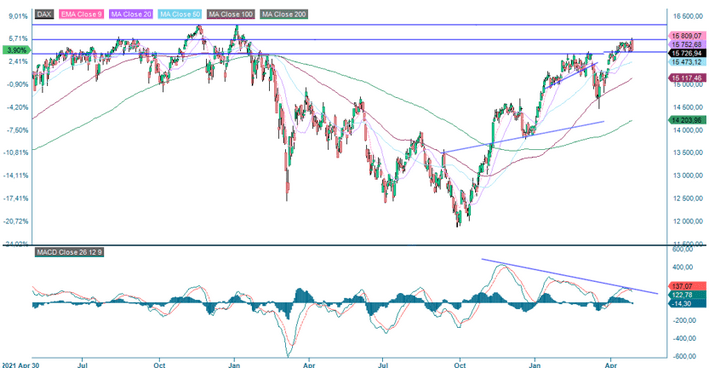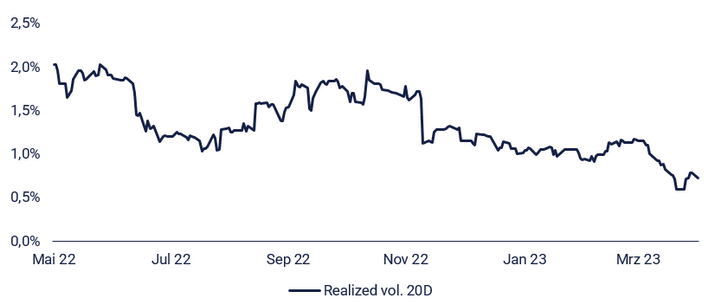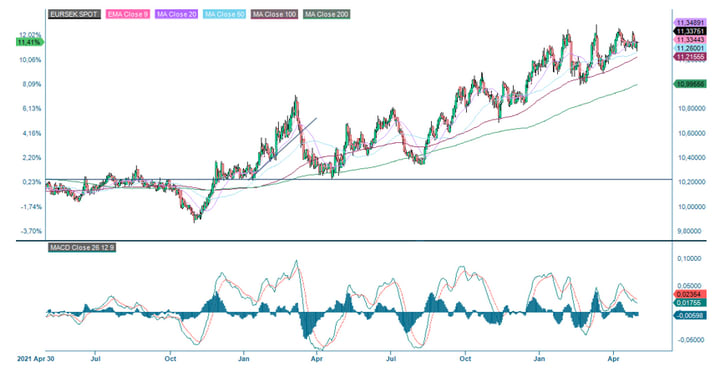Increased worries for US banks while VIX is at 12 months low

Concerns about regional banks drove US interest rates lower yesterday. The market is awaiting interest rate announcements from the Fed and the ECB this week. The US volatility index VIX is at record lows and could be at attractive levels in our view. We are also looking at the challenges for the SEK to strengthen.
Fed, ECB and US employment announcements this week
On Friday, 28 April, the New York Stock Exchange had its focus on First Republic Bank after news that JP Morgan is taking over the troubled bank for USD 10.6bn.
Interest rates rose in the United States on Monday, 1 May. The US 2-year Treasury yield rose to 4.14%, an increase of about ten basis points compared with Friday, 28 April. A contributory factor was that purchasing managers' index for the industry came in slightly higher than expected. The industrial PMI rose to 47.1 in April from 46.3 in March. The consensus was 46.8. In China, industrial PMI fell to 49.2 from 51.9 in the previous month and the services PMI fell to 56.4 from 58.2.
Yesterday, rates were down on increased worries about the health of regional banks in the US. The US 2-year Treasury yield was traded at 3.99% on Tuesday evening, 2 May.
On Thursday, 4 May, the ECB will announce its interest rate decision. In the eurozone, core inflation is still on the rise. For that reason, a rate hike is almost inevitable. The bond market expects two more rate hikes from the ECB. For the Fed, the last rate hike of this economic cycle is anticipated on Wednesday, 3 May.
The focus on the debt ceiling in the US has increased. Yellen flagged on 1 May that the US government could run out of money as early as 1 June. Some measures mean that the date could be moved forward a few weeks. Biden will discuss the debt ceiling with US congressional leaders next week.
We will get employment data from the US on Wednesday, May 3 and Friday, May 5. Wednesday's ADP employment report figures are expected to show 150K new jobs, compared to 145K new jobs last month. As for Friday's Non-Farm Payrolls, the market expects 180K new jobs to have been created in the US, compared to 236K new jobs last month.
Germany 2-year Treasury yield (in %), two-year daily chart

Over the past week, the Nasdaq has gained 1.4% from robust quarterly reports from some significant IT giants. The Nikkei gained about 2% last week. At the same time, the OMX30 continues to perform poorly. Swedish company reports from the engineering sector have been strong, including order intake. But cumulatively, since 21 March, only 63% of OMX companies have beaten earnings expectations in Q1 2023.
S&P 500 Q1 2023 results and upcoming reports
For Q1 2023 (with around 53% of the companies reporting), 79% of S&P companies have reported a positive EPS (Earnings per share) surprise, while 74% have reported a positive revenue surprise. That is a significant improvement on the revenue side compared to last week (21 April).
The top three sectors in earnings outcomes in Q1 2023 were Energy, Consumer Staples, and Materials, with 100%, 99% and 92% of results better than expected, respectively. Utilities, Financials and Real Estate are the worst performers, with 56%, 62% and 63% of Q1 2023 earnings better than anticipated.
As of 31 March 2023, analysts were forecasting a -6.7% decline in earnings for Q1 2023. This expected earnings decline has decreased to -3.7% as of 28 April 2023.
For Q2 2023, 28 S&P500 companies have issued negative EPS guidance, while 20 have issued positive EPS guidance.
This week, 162 S&P 500 companies will report their Q1 2023 results. Among the big caps, Qualcomm will release its Q1 report on Wednesday, 3 May, Apple, Anheuser Busch and Conoco Philips on Thursday, 4 May and Berkshire Hathaway on Friday, 5 May.
Be careful out there: Still bearish from a technical perspective
S&P 500 is trading below its short-term moving averages, EMA9 and MA20, under negative divergence to the MACD indicator. A break below the bottom of the bearish rising wedge formation and formation indicates a setback to levels around 3,800, where resistance is found. Note that important MA100 and MA200 need to be broken on the way down. If instead a break to the upside, above 4,200, the next level is around 4,300, where the index topped in August 2022. Thus, the risk/reward could be more attractive in the long case.
S&P 500 (in USD), two-year daily chart

In the weekly chart below, the short trend is still upward-sloping. However, a break below EMA9 is not good for the short-term rising trend.
S&P 500 (in USD), weekly five-year chart

Nasdaq 100 is trading close to its short-term moving averages, EMA9 and MA20. A break on the downside, and MA100, currently at 12,642, could be next. If this level also is broken, 11,000 is the next level, as the bearish rising wedge formation indicates. In a continued upwards movement, the next level is around 13,700.
Nasdaq 100 (in USD), two-year daily chart

Nasdaq 100 (in USD), weekly five-year chart

In Sweden, the same negative divergence exists between the index OMXS30 and MACD. OMXS30 closed yesterday’s trading close to MA20. A break on the downside and MA100 at 2,184 may be next. The next level after that is found around 2,135.
OMXS30 (in SEK), two-year daily chart

OMXS30 (in SEK), weekly five-year chart

Also, the German DAX closed near its short-term moving averages, EMA9 and MA20. Continued selling pressure and MA100, currently at 15,473, maybe subsequent. On the upside, the 16,000 level needs to be broken before the tops from November 2021 and January 2022, just below 16,300, can be tested. Note again the negative divergence between the index and MACD.
DAX (in EUR), one-year daily chart

In the weekly chart, momentum is fading, as illustrated by the MACD histogram.
DAX (in EUR), weekly five-year chart

VIX is still at low levels
VIX is trading near its 12 months low. See the chart below. If the equity markets turn south, there could be some potential upside in VIX.
VIX and S&P 500 (in USD), one-year daily chart
VIX and S&P 500 (in USD), one-year daily chart

A part of the explanation for the low levels in VIX is the low realised volatility in S&P 500, which is also near its 12 months low.
Realised 20 day volatility in S&P 500 (%), one-year daily chart

VIX (in USD), five-year daily chart

Case of the week: Stronger SEK is an uphill battle
The Swedish central bank raised its repo rate by 50 basis points to 3.5% on Wednesday, 26th April, taking borrowing costs to their highest level since December 2008.
Policy rates need to be raised to affect inflation, which is expected to fall, and the krona will strengthen. Following the announcement, the Swedish krona depreciated against the US dollar and the euro. This depreciation is likely because monetary policy has become tighter, and uncertainty has increased. Small economies such as Sweden tend to depreciate currencies in an environment of increased uncertainty.
However, the Swedish krona has depreciated over the last decade, even during economic boom periods. The need for more confidence that the Riksbank wants a stronger krona comes into play, as does the small size of the SEK in foreign exchange trading. Other reasons include the impact of continuously increased policy rates on the housing market in Sweden. This could cause more uncertainty among international investors as market price in the housing market has fallen, which may lead to considerably reduced exposure to the financial market in Sweden since the housing market is intertwined with the financial market.
Indeed, as an exporting country, Sweden has historically benefited from a relatively weak currency. Former Riksbank Governor Stefan Ingves said several times that the Riksbank did not dislike a weak SEK because it favoured Swedish exporters. Some currency traders still remember this. It has given the new Riksbank governor, Thedéen, an uphill struggle to strengthen the SEK.
In theory, there should be a positive correlation between the value of the Swedish krona and the central bank's policy rate. Other macroeconomic indicators, such as the current account and trade balance surpluses or the decline in the manufacturing PMI, should indicate the same trend. The continued depreciation tends to be attributed to explanations such as the floating exchange rate in Sweden, where the relationship between supply and demand determines the value. Market participants have continued to sell the krona for US dollars for long periods, the so-called “flight to quality”.
There have been discussions about central bank intervention. In other words, the central bank sells bonds, thereby taking money out of the money market and reducing the money supply, which should lead to an appreciation of the krona. However, according to the Swedish central bank, it is too early to use this instrument.
The scenario of an appreciating krona may be plausible. However, this depreciation pattern will likely continue until the end of 2023, when macroeconomic stability is achieved.
The underlying for the instruments below is SEK per 1 EUR
EUR/SEK, one-year daily chart

EUR/SEK, five-year weekly chart

The full name for abbreviations used in the previous text:
EMA 9: 9-day exponential moving average
Fibonacci: There are several Fibonacci lines used in technical analysis. Fibonacci numbers are a sequence of numbers in which each successive number is the sum of the two previous numbers.
MA20: 20-day moving average
MA50: 50-day moving average
MA100: 100-day moving average
MA200: 200-day moving average
MACD: Moving average convergence divergence
Risks
External author:
This information is in the sole responsibility of the guest author and does not necessarily represent the opinion of Bank Vontobel Europe AG or any other company of the Vontobel Group. The further development of the index or a company as well as its share price depends on a large number of company-, group- and sector-specific as well as economic factors. When forming his investment decision, each investor must take into account the risk of price losses. Please note that investing in these products will not generate ongoing income.
The products are not capital protected, in the worst case a total loss of the invested capital is possible. In the event of insolvency of the issuer and the guarantor, the investor bears the risk of a total loss of his investment. In any case, investors should note that past performance and / or analysts' opinions are no adequate indicator of future performance. The performance of the underlyings depends on a variety of economic, entrepreneurial and political factors that should be taken into account in the formation of a market expectation.
Disclaimer:
This information is neither an investment advice nor an investment or investment strategy recommendation, but advertisement. The complete information on the trading products (securities) mentioned herein, in particular the structure and risks associated with an investment, are described in the base prospectus, together with any supplements, as well as the final terms. The base prospectus and final terms constitute the solely binding sales documents for the securities and are available under the product links. It is recommended that potential investors read these documents before making any investment decision. The documents and the key information document are published on the website of the issuer, Vontobel Financial Products GmbH, Bockenheimer Landstrasse 24, 60323 Frankfurt am Main, Germany, on prospectus.vontobel.com and are available from the issuer free of charge. The approval of the prospectus should not be understood as an endorsement of the securities. The securities are products that are not simple and may be difficult to understand. This information includes or relates to figures of past performance. Past performance is not a reliable indicator of future performance.
© Bank Vontobel Europe AG and/or its affiliates. All rights reserved.
